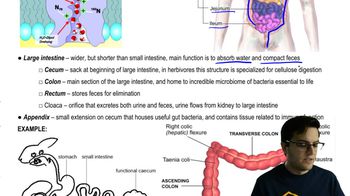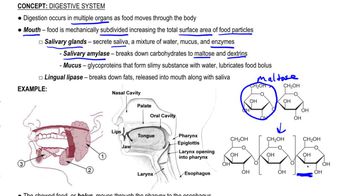Table of contents
- 1. Introduction to Biology2h 42m
- 2. Chemistry3h 40m
- 3. Water1h 26m
- 4. Biomolecules2h 23m
- 5. Cell Components2h 26m
- 6. The Membrane2h 31m
- 7. Energy and Metabolism2h 0m
- 8. Respiration2h 40m
- 9. Photosynthesis2h 49m
- 10. Cell Signaling59m
- 11. Cell Division2h 47m
- 12. Meiosis2h 0m
- 13. Mendelian Genetics4h 44m
- Introduction to Mendel's Experiments7m
- Genotype vs. Phenotype17m
- Punnett Squares13m
- Mendel's Experiments26m
- Mendel's Laws18m
- Monohybrid Crosses19m
- Test Crosses14m
- Dihybrid Crosses20m
- Punnett Square Probability26m
- Incomplete Dominance vs. Codominance20m
- Epistasis7m
- Non-Mendelian Genetics12m
- Pedigrees6m
- Autosomal Inheritance21m
- Sex-Linked Inheritance43m
- X-Inactivation9m
- 14. DNA Synthesis2h 27m
- 15. Gene Expression3h 20m
- 16. Regulation of Expression3h 31m
- Introduction to Regulation of Gene Expression13m
- Prokaryotic Gene Regulation via Operons27m
- The Lac Operon21m
- Glucose's Impact on Lac Operon25m
- The Trp Operon20m
- Review of the Lac Operon & Trp Operon11m
- Introduction to Eukaryotic Gene Regulation9m
- Eukaryotic Chromatin Modifications16m
- Eukaryotic Transcriptional Control22m
- Eukaryotic Post-Transcriptional Regulation28m
- Eukaryotic Post-Translational Regulation13m
- 17. Viruses37m
- 18. Biotechnology2h 58m
- 19. Genomics17m
- 20. Development1h 5m
- 21. Evolution3h 1m
- 22. Evolution of Populations3h 52m
- 23. Speciation1h 37m
- 24. History of Life on Earth2h 6m
- 25. Phylogeny2h 31m
- 26. Prokaryotes4h 59m
- 27. Protists1h 12m
- 28. Plants1h 22m
- 29. Fungi36m
- 30. Overview of Animals34m
- 31. Invertebrates1h 2m
- 32. Vertebrates50m
- 33. Plant Anatomy1h 3m
- 34. Vascular Plant Transport1h 2m
- 35. Soil37m
- 36. Plant Reproduction47m
- 37. Plant Sensation and Response1h 9m
- 38. Animal Form and Function1h 19m
- 39. Digestive System1h 10m
- 40. Circulatory System1h 57m
- 41. Immune System1h 12m
- 42. Osmoregulation and Excretion50m
- 43. Endocrine System1h 4m
- 44. Animal Reproduction1h 2m
- 45. Nervous System1h 55m
- 46. Sensory Systems46m
- 47. Muscle Systems23m
- 48. Ecology3h 11m
- Introduction to Ecology20m
- Biogeography14m
- Earth's Climate Patterns50m
- Introduction to Terrestrial Biomes10m
- Terrestrial Biomes: Near Equator13m
- Terrestrial Biomes: Temperate Regions10m
- Terrestrial Biomes: Northern Regions15m
- Introduction to Aquatic Biomes27m
- Freshwater Aquatic Biomes14m
- Marine Aquatic Biomes13m
- 49. Animal Behavior28m
- 50. Population Ecology3h 41m
- Introduction to Population Ecology28m
- Population Sampling Methods23m
- Life History12m
- Population Demography17m
- Factors Limiting Population Growth14m
- Introduction to Population Growth Models22m
- Linear Population Growth6m
- Exponential Population Growth29m
- Logistic Population Growth32m
- r/K Selection10m
- The Human Population22m
- 51. Community Ecology2h 46m
- Introduction to Community Ecology2m
- Introduction to Community Interactions9m
- Community Interactions: Competition (-/-)38m
- Community Interactions: Exploitation (+/-)23m
- Community Interactions: Mutualism (+/+) & Commensalism (+/0)9m
- Community Structure35m
- Community Dynamics26m
- Geographic Impact on Communities21m
- 52. Ecosystems2h 36m
- 53. Conservation Biology24m
39. Digestive System
Digestion
Problem 5`
Textbook Question
Explain the role in nutrition of each of the following structures:
bird crop, cow rumen, and elephant cecum.
 Verified step by step guidance
Verified step by step guidance1
The bird crop is a pouch-like structure located in the esophagus of birds. Its primary role in nutrition is to store food temporarily. This allows birds to consume food quickly and then digest it later when they are safe from predators. The crop also softens food, making it easier to digest when it moves to the stomach.
The cow rumen is the largest compartment of the cow's stomach, part of a complex digestive system known as the ruminant system. The rumen's role in nutrition is to serve as a fermentation vat where microorganisms break down fibrous plant material, such as cellulose, into simpler compounds. This process allows cows to extract nutrients from plant-based diets that are otherwise indigestible.
The elephant cecum is a large pouch located at the beginning of the large intestine. Its role in nutrition is to aid in the digestion of plant material through microbial fermentation. The cecum helps break down cellulose and other complex carbohydrates, allowing elephants to absorb nutrients from their herbivorous diet.
Each of these structures is adapted to the specific dietary needs of the animal. Birds benefit from quick food storage and softening, cows rely on microbial fermentation to digest tough plant fibers, and elephants use their cecum to maximize nutrient absorption from a plant-based diet.
Understanding these structures highlights the diversity of digestive adaptations in animals, reflecting their evolutionary responses to dietary challenges and ecological niches.
 Verified video answer for a similar problem:
Verified video answer for a similar problem:This video solution was recommended by our tutors as helpful for the problem above
Video duration:
2mPlay a video:
Was this helpful?
Key Concepts
Here are the essential concepts you must grasp in order to answer the question correctly.
Bird Crop
The bird crop is a pouch-like structure located in the esophagus of many birds. It serves as a storage site for food, allowing birds to consume large amounts quickly and digest it later. This adaptation is particularly useful for birds that need to eat quickly due to predation risks or those that feed their young by regurgitation.
Recommended video:
Guided course

Birds and Synapsids
Cow Rumen
The rumen is the largest compartment of a cow's stomach, playing a crucial role in digestion. It hosts a complex community of microorganisms that break down fibrous plant material through fermentation, allowing cows to extract nutrients from cellulose-rich diets. This symbiotic relationship is essential for converting plant matter into energy and nutrients.
Recommended video:
Guided course

Stomach
Elephant Cecum
The cecum in elephants is a large, sac-like structure at the beginning of the large intestine. It functions in the fermentation of plant material, aiding in the digestion of cellulose. The cecum's microbial population helps break down tough plant fibers, allowing elephants to derive nutrients from their herbivorous diet efficiently.
Recommended video:
Guided course

Large Intestine
Related Videos
Related Practice














![Anatomy and Physiology of the Large Intestine [Colon]](https://img.youtube.com/vi/F4W2DLIKXww/mqdefault.jpg)




![IGCSE BIOLOGY REVISION - [Syllabus 7.5] Absorption](https://img.youtube.com/vi/TEOB94oBZN4/mqdefault.jpg)


























